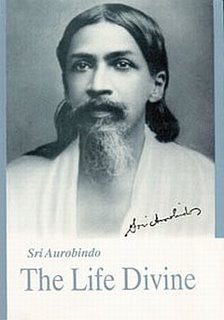 |
The Ascent of Life
Exploring the motive of evolution – the middle terms
The first terms of life were represented in unending divisibility that was needed to produce unique forms and was coeval with physical energy that seemed to follow a subconscient will in the organisation and distribution of forms in time and space.
The subconscient will is not an isolated phenomenon, it is a formulation of a greater energy or force and energy cannot be isolated but must be in communion with an universal energy. However the subconscient will must not be merely a formulation of universal energy but a projection of a dynamic, creative force, the Heraclitean fire and more than that, an evolutionary force in Aurobindonian terms.
The evolutionary nisus surges ahead beyond the first terms of life. The first terms, divisibility and physical energy are the subject of consciousness researchers and physical scientists who are concerned with the material perspective of consciousness and the mechanical energy supporting it. The second terms of life are concerned with a richer and variegated life evolving beyond the material substrate, a life pulsating with dynamism, desires, aggression, expansion –a life that swings with the modulations of energy and alternates with depletion of energy culminating in the phenomenon of death. In this grand matrix, the fittest are more prone to exceed others in the evolutionary pace and this movement is represented in the famous Darwinian assertion of the survival of the fittest.
|
|
Sri Aurobindo describes: ‘...there comes a new equipoise, there intervenes a new set of terms which increase in proportion as Life delivers itself out of this form and begins to evolve towards conscious Mind; for the middle terms of Life are death and mutual devouring, hunger and conscious desire, the sense of a limited room and capacity and the struggle to increase, to expand, to conquer and to possess. These… terms are the basis of that status of evolution which the Darwinian theory first made plain to human knowledge’ (The Life Divine, pg.213).
He then expands on these middle terms:
(a) Death itself is inherent in the struggle to survive since ‘it is only the negative term in which Life hides from itself and tempts its own positive being to seek for immortality’ (Ibid). How true! When scientists working with nanotechnology claim that death can be withheld by preventing the shortening of chromosome tails (telomeres), it only demonstrates how Life hides behind the mask of death!
(b) Hunger and desire involve ‘a struggle towards a status of satisfaction and security, since desire is only the stimulus by which Life tempts its own positive being to rise out of the negation of unfulfilled hunger towards the full possession of the delight of existence’. In other words, if desire stimulates the motivation for material life, it can also act as the internal energizer for a higher life and for contacting the Bliss-principle of existence
(c) The limited capacity of life initiates the struggle for ‘expansion, mastery and possession, the possession of the self and conquest of the environment’ (ibid). To existentialists, the concept of possession defined as ‘the phenomenon of that which is our own’ is an ‘integral part of our personality’ (Minkowski, E in Existence-A New Dimension in Psychiatry and Psychology, Ed. By R.May, E.Angel, HF Ellenberger, Clarion, NY, 1967 paperback edition, p.138). In certain forms of psychopathology, this phenomenon is disturbed and altered and gives rise to such symptoms as the feeling of being a ‘broke’ or negative ideation of not having viscera.
(d) The struggle for perfection is as important as the struggle to survive and the struggle for possession for ‘only a greater and greater perfection can assure a continuous permanence, a lasting survival’ (Ibid, pg.214). This is also implicit in the Darwinian expression of survival of the fittest.
The scientist’s dilemma
Evolution started from the material matrix that was the first to emerge from the flux of Inconscience. The first basis of evolution was therefore mechanical in nature. When Life animated Matter, the whole equation was changed by the infusion of this new principle. The outstanding feature of this new equation was that the primary superiority of Matter was challenged as Life’s reason of being was to subject to itself the mechanical principle of existence based on Matter. Life was to dominate Matter and outgrow the limitations of the mechanical laws. Sri Aurobindo points out, rather lucidly that a section of scientists have disregarded this claim of Life to subjugate Matter and in the process sought to understand the higher consciousness implicit in Life through the mechanical consciousness concealed in Matter. In other words, they tried to interpret Life in the same way as they understood the mechanical laws of Matter. In the process they exaggerated certain Darwinian principles to areas where they needed to be surpassed –‘the Darwinian formula was used to extend too largely the aggressive principle of Life, the vital selfishness of the individual, the instinct and process of self-preservation, self-assertion and aggressive living’ (Ibid). However Matter and Life are not the only principles in existence, they are followed by a yet higher mind-principle that manifests at an optimal point in consciousness. Understandably, as consciousness progresses through the trajectory of evolution, the primitive values and qualities of existence are supplemented by higher values and qualities and at a certain stage, universal values manifest to supplement individual values. Thus the Darwinian principle of aggressive expansion cannot be applied to all domains of consciousness.
Date of Update:
19-May-18
- By Dr. Soumitra Basu
|

